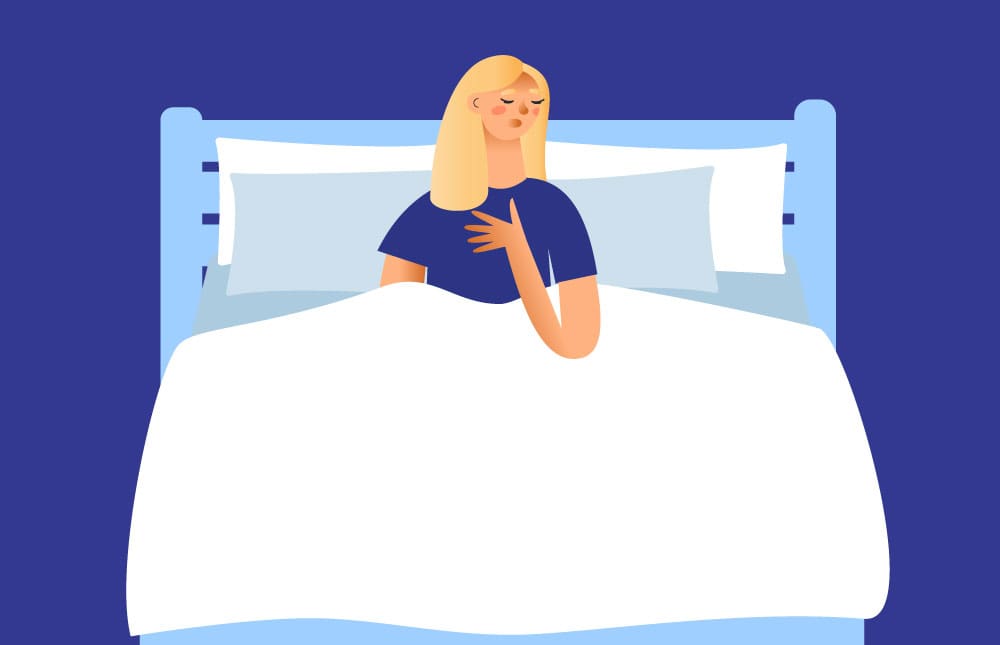If you suffer from breathing problems, you know how important it is to get a good night’s sleep. Finding the best sleeping position to help alleviate your breathing issues can make a world of difference in the quality of your sleep and ultimately your overall health and well-being.

Credit: sleepopolis.com
Importance of Sleeping Position
Most of us are unaware of the impact our sleeping position can have on our breathing. A good sleeping position for breathing problems can help open up your airways, reduce snoring, and make it easier to breathe throughout the night. Here are a few sleeping positions that can help improve your breathing.
1. Elevated Upper Body
Elevating the upper body has been found to be an effective sleeping position for people with breathing problems. By using a wedge pillow or adjustable bed, you can elevate your upper body, which can help reduce acid reflux and relieve pressure on your chest, making it easier to breathe.
2. Side Sleeping
Many people find relief from breathing problems by sleeping on their side. This position can help keep your airways open and reduce the likelihood of snoring, making it a great option for those with sleep apnea or allergies.
3. Prone Position
For some individuals, lying in a prone position (on the stomach) can improve breathing. This position can help prevent the tongue from falling backward and blocking the airway, making it easier to breathe for those with certain types of breathing problems.
Tools and Methods
While finding the best sleeping position is important, there are other tools and methods that can further enhance your ability to breathe comfortably while you sleep.
1. Pillows
Using the right pillow can make a significant difference in your ability to breathe while sleeping. A contour pillow can help keep your airways open, while a wedge pillow can elevate your upper body and reduce pressure on your chest.
2. Humidifier
Adding moisture to the air with a humidifier can help alleviate breathing problems caused by dry air, particularly for those with allergies or congestion. Maintaining an optimal level of humidity in the bedroom can make it easier to breathe while you sleep.
3. Nasal Strips
Nasal strips are another helpful tool for improving breathing while sleeping. These strips can help open up your nasal passages, reduce snoring, and make it easier to breathe, especially if you suffer from allergies or nasal congestion.

Credit: www.healthline.com
Frequently Asked Questions Of Sleep Your Way To Better Breathing: Discover The Best Sleeping Position For Breathing Problems
What Is The Best Sleeping Position For Breathing Problems?
The best sleeping position for breathing problems is sleeping on your side. This position helps to open up the airways and improve breathing.
Why Is Sleeping On Your Side Beneficial For Breathing Problems?
Sleeping on your side is beneficial for breathing problems because it helps to prevent the collapse of the airways and keeps them open, allowing for better airflow.
Can Sleeping On Your Back Worsen Breathing Problems?
Yes, sleeping on your back can worsen breathing problems, especially for people with conditions like sleep apnea. This position can cause the airway to become partially or completely blocked, leading to breathing difficulties.
What Should You Do If You Can’t Sleep On Your Side?
If you can’t sleep on your side, you can try using a pillow or a specially designed wedge to elevate your upper body. This can help to keep the airways open and reduce breathing difficulties.
Conclusion
Finding the best sleeping position for breathing problems is crucial for improving the quality of your sleep and overall health. Experiment with different sleeping positions, use the right tools and methods, and consult a healthcare professional if your breathing problems persist. By making these adjustments, you can enjoy better sleep and wake up feeling more refreshed and rejuvenated.
Remember, the quality of your sleep matters, and taking steps to improve your breathing while sleeping can have a significant impact on your well-being.
For more information on how to improve your sleep and breathing, consult a healthcare professional for personalized advice tailored to your specific needs.
{ “@context”: “https://schema.org”, “@type”: “FAQPage”, “mainEntity”: [ { “@type”: “Question”, “name”: “What is the best sleeping position for breathing problems?”, “acceptedAnswer”: { “@type”: “Answer”, “text”: “The best sleeping position for breathing problems is sleeping on your side. This position helps to open up the airways and improve breathing.” } } , { “@type”: “Question”, “name”: “Why is sleeping on your side beneficial for breathing problems?”, “acceptedAnswer”: { “@type”: “Answer”, “text”: “Sleeping on your side is beneficial for breathing problems because it helps to prevent the collapse of the airways and keeps them open, allowing for better airflow.” } } , { “@type”: “Question”, “name”: “Can sleeping on your back worsen breathing problems?”, “acceptedAnswer”: { “@type”: “Answer”, “text”: “Yes, sleeping on your back can worsen breathing problems, especially for people with conditions like sleep apnea. This position can cause the airway to become partially or completely blocked, leading to breathing difficulties.” } } , { “@type”: “Question”, “name”: “What should you do if you can’t sleep on your side?”, “acceptedAnswer”: { “@type”: “Answer”, “text”: “If you can’t sleep on your side, you can try using a pillow or a specially designed wedge to elevate your upper body. This can help to keep the airways open and reduce breathing difficulties.” } } ] }
Leave a Reply